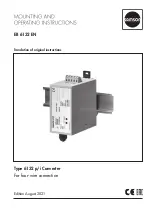
Balancing and Counterweight Adjustments
•
Balancing and set-up is crucial to getting the most out of your Track Rack™
•
Start by ensuring that the module rails are installed equidistant from the center axle.
•
Pay attention to balance when installing additional components (inverters, wires /
conduit, etc.)
•
Track Racks™ will work within a range of
Counterweight adjustments.
•
If the tracker is not going through the full travel range,
raise the Counterweight.
•
Keeping the Counterweight low will make the tracker
more stable in wind.
•
Provided that additional stability is not required for
gusty winds, the optimal Counterweight position results
in the Truss Tube lightly touching the Bumper Bolt at
the beginning and end of the day (when all Freon has
been shifted).
Seasonal Adjustments
•
Trackers can be tilted in one position or adjusted seasonally to increase output.
Adjusting tilt throughout the year can add approximately 3-6% to the annual output (will
vary with location, climate, etc).
•
If setting the rack for one year-round setting, the tilt should be close to the latitude.
For example: In Albuquerque, NM
(latitude 35.1° N) a tracker
should be tilted close to 35°
(as measured from
horizontal). The Seasonal
Adjustment Plate offers a
position of 35° – this angle will
work well.
•
If adjusting the rack throughout the
year, adjust the tilt so that the sun
hits the surface of the modules as
close to a right angle as possible.
•
A good compromise is to adjust the
rack to a tilt of la 15° (or
max.) around the fall equinox
(September 22
th
) and latitude – 15°
(or min.) around the spring equinox
(March 20
th
).
•
After setting the tilt of the rack, tighten the 5/8” pivot bolt to 75 ft-lbs, and the
1/2” bolt to 30 ft-lbs.
COUNTERWEIGHT
POSITION
LOWER
HIGHER
•
MORE STABLE
•
LESS MOVEMENT
•
MORE MOVEMENT
•
(POSSIBLE) FASTER
WAKE-UP
•
MORE EASILY BLOWN
OFF-COURSE
•
"SEARCHING" FOR SUN
•
FULL MOVEMENT WITH
FULL SHIFT OF
REFRIGERANT
•
GOOD STABILITY
•
REASONABLE WAKE-UP
TIMES


































